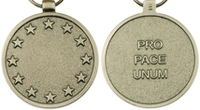| Common Security and Defence Policy Service Medal | |
|---|---|
 Common obverse and reverse of the medal | |
| Type | Service Medal |
| Awarded for | At least 30 days of service for each mission |
| Presented by | |
| Eligibility | Civilian and military members of CSDP missions |
| Motto | Pro Pace Unum (Together For Peace) |
| Status | Currently awarded |
| Established | 1 January 2003 [1] |
| First award | 2004 |
| CSDP ALTHEA Operations medal ribbon bar CSDP ALTHEA Staff medal ribbon bar [2] CSDP EUTM Mali Medal for Extraordinary Meritorious Service [3] | |
| Precedence | |
| Next (higher) | Varies by country |
| Next (lower) | Varies by country |

The Common Security and Defence Policy Service Medal (named the European Security and Defence Policy Service Medal prior to 2009) is an international military decoration awarded to individuals, both military and civilian, who have served with CSDP missions. Since the 1990s the European Union has taken a greater role in military missions both in Europe and abroad. These actions were taken under the Common Security and Defence Policy (CSDP), which is implemented by the European Union Military Staff, a department of the EU. To recognize service in these missions the EU authorized the creation of a medal with a common obverse and reverse, to which clasps featuring the missions' name are attached to the ribbon bar. [4]